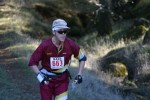Sunol Regional Wilderness
Date: (Sun.) Feb. 7, 2016
Location: Sunol, CA
Event Director: - 408.878.5073
Course Setters: Daniel Å ebo, Matej Sebo, Lubomir Sebo
Type: B; Full set of courses, from Beginner to Advanced; COOL event #2
Course Setters' Notes
By Daniel, Matej, and Lubomir Å ebo
It's time once again to return to the lush, rolling slopes of Sunol Regional Wilderness. While it's a little too early in the season for wildflowers, the grass is green, the streams are full of rushing water, and the views are as stunning as ever.
Important Event-Day Information
There will be two Start locations for this event:
- The Start for the White and Yellow courses is about 150 meters from the registration area (a short, 2-minute walk).
- The Start for the Orange, Brown, Green, Red, and Blue courses will be 1.7 km from the registration area, up a gradual hill (about 200 meters of climb). It will take about 20–35 minutes of walking to reach this location.
There will be a single common finish location for all courses. It will be in close proximity to the registration area.
Map comments
Originally drafted in 1991, the Sunol map is beginning to show its age, especially when it comes to vegetation. Areas near controls have been systematically revised. Still, many thickets have expanded, and some areas of once-passable undergrowth have now become nearly impenetrable. In general, it is a good idea to completely avoid areas marked with dark green on the map. Small areas of vertical green slash are generally passable, but avoiding them on major route choices is recommended.
The scale is 1:7,500 for White and Yellow courses, and 1:10,000 for the Orange, Brown, Green, Red, and Blue courses. The contour interval for all courses is 7.5 meters, which is quite a bit higher than the standard 5 meters. This means that slopes will be steeper than they might appear on the map. Please keep this in mind, especially when planning route choices.
All major trails and fences that you will encounter are on the map. Almost all major fences are made of barbed wire; gates are indicated with the black crossing-point symbol or by a gap in the fence line. These crossing points are not mandatory, but they do help in negotiating the barbed-wire fences. It is also usually possible to crawl underneath the lowest strand of barbed wire.
Large lone trees are mapped with the hollow green circle symbol; small lone trees and bushes are shown as green dots. Brown ×'s are fallen trees; green ×'s are dead trees that are still standing. (Note: These are different from older versions of the map!) On the control description sheet, fallen trees are marked with the rootstock symbol, and dead trees are marked with the "tree, ruined" symbol. Not all fallen and dead trees are on the map.
Hazards
Poison oak is present, and most courses avoid it; however, it might be present along some route choices on the advanced courses. Areas mapped as dark green (completely avoidable) are often massive poison oak bushes, and areas mapped as undergrowth often contain areas of poison oak as well. Long pants are recommended, as is washing with cold water and soap (or Tecnu) after the event.
There are a few steep re-entrants in the park that the Green, Red, and Blue courses will encounter. Cow paths are generally the best way to cross re-entrants, and some of the more distinct ones are marked on the map.
Participants on the Orange, Green, Red, and Blue courses will have to cross one or more barbed-wire fences; crawling underneath the lowest, loose wire is recommended.
- Special note to those on the Orange course: There is a fallen barbed-wire fence close to one of the controls; parts of it are marked with orange streamers. The barbed wire is barely visible until you are almost on top of it, so watch your step!
Wildlife is generally skittish and sparse, although there are many wild turkeys in the valley at this time of year. There are a lot of cows in the park as well, but these are docile if not antagonized. Please be careful not to come between a mother cow and her calf.
Footing can be quite slippery, especially if there is rain in the days leading up to the event. Shoes with good grip are advised, especially if you are planning to head out on Orange, Brown, Green, Red, or Blue.
Although this is technically not a hazard, we would also like to remind all runners to carefully read the map when approaching a control. Remember that not all of the controls you see will be on your course, so remember to check each control code before punching.
Course Statistics
Water Navigational Physical
Course Distance Climb Controls stops Difficulty Difficulty
White 2.5 km 125 m 10 0 Very easy Easy
Yellow 3.6 km 150 m 13 0 Easy Moderate
Orange 4.5 km 130 m 14 2 Moderate Moderate
Brown 4.2 km 90 m 18 2 Difficult Easy
Green 5.7 km 210 m 27 2 Difficult Difficult
Red 7.0 km 375 m 21 2 Difficult Very difficult
Blue 7.8 km 470 m 24 3 Difficult Grueling
Although there will be water stops on all of the intermediate and advanced courses, carrying water is recommended, especially if you are starting later in the day.
The course distance is measured along the straight lines between controls—your actual distance will be longer. Climb is measured along the optimal route (in the course setter's opinion)—your actual climb may be less or more, depending on your route choices.

